Stories of NRM partners
Strong partnerships between government, industry and communities in the Geographe catchment of southwest Western Australia proved to be the key to encouraging local dairy farmers to reduce effluent runoff.
Strong partnerships between government, industry and communities in the Geographe catchment of southwest Western Australia proved to be the key to encouraging local dairy farmers to reduce effluent runoff.
“As well as strong partnerships we had a Project Reference Group of stakeholders including catchment coordinators, Government departments, industry representatives and farmers. That ‘helicopter’ look was very useful, to have all the heads together to work through any challenges along the way.”
The catchment is home to the Vasse Wonnerup System, a wetland of international importance where shallow, nutrient-rich waters provide dry season habitat for tens of thousands of resident and migrant waterbirds in close proximity to residential, farming and tourism areas.
The DairyCare partnership program between Western Dairy and GeoCatch, with support from the Department of Water & Environmental Regulation, saw 10 farmers receive funding to upgrade their effluent systems and 85% of farmers in the Geographe Catchment benchmarked against the Code of Practice for Dairy Shed Effluent WA.
Effluent from dairy farms can pose a risk to nutrients entering waterways, but if managed well it provides a valuable source of organic matter and fertiliser for pasture and crops. However upgrading the effluent system can be complicated and expensive, and programs such as DairyCare support farmers to make the changes sooner rather than later, says DairyCare coordinator, Bree Brown.
“There’s a lot of components like pumps, pipes and storage ponds that need to be carefully designed and the bigger the farm, the more extensive the effluent system is likely to be. Without these incentives, many farmers wouldn’t have taken the steps in the time frame they have,” she says.
A challenge for the project was a lack of specific effluent management service providers. Western Dairy’s project officer provided technical support and developed a plan for each farm with the help of an effluent design consultant in the eastern states. GeoCatch promoted and managed funding incentives for each upgrade while DWER provided training for more service providers and facilitated the Project Reference Group and Technical Working Group to build capacity for more challenging farms.
Upgrade projects were completely voluntary but the expressions of interest process was oversubscribed by farmers, as the regulatory environment tightens and processors look to their suppliers to demonstrate sustainable milk production.
Project partners and stakeholders also had input into a review of the 2012 Code of Practice for Dairy Shed Effluent WA, with a new Code to be released in 2021.
Website – https://rgw.dwer.wa.gov.au/reducing-nutrients/reducing-nutrients-off-farm/
As host for the Western Dairy Research, Development and Extension Hub – providing human resources support and project management capacity for DairyCare – South West Catchments Council (now South West NRM) was proud to promote the DairyCare aims and outcomes to farmers and the general community.





Funded by: Royalties for Regions through Revitalising Geographe Waterways and the Regional Estuaries Initiative via partnerships between the State Government, Department of Water & Environmental Regulation, GeoCatch and Western Dairy.
